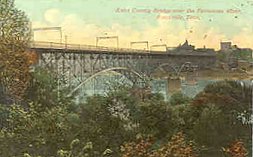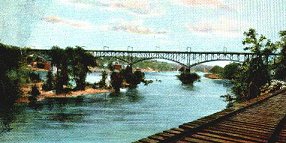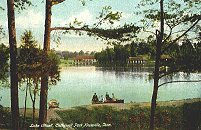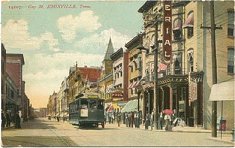


From Rule's Standard History of Knoxville, Tennessee, with Full Outline of the Natural Advantages, Early Settlement, Territorial Government, Indian Troubles and General and Particular History of the City Down to the Present Time. Chicago: The Lewis Publishing Company, 1900.
Mr. J. E. Patten, one of the proprietors of the cable line, as soon as practicable after the accident, procured a cable rope 600 feet in length, and throwing it over the cable supporting the car, slid it down to the car, the ends of this rope being securely held by boatmen below. Then making a loop seat, Mr. Patten was drawn up to the car from the launch Vollette, taking with him block and tackle, which he so fastened to the cable that all the living passengers could readily descend. The body of Mr. Ledgerwood was then taken down, and the excitement, which was very great throughout the city, then subsided. A coroner's jury announced as their verdict that Mr. Ledgerwood came to his death through the breaking of the cable of the cable car which runs from the north to the south side of the river, at what is known as Longstreet's Heights, and that the accident was due to the carelessness of the owners of the cable in not guarding or protecting it, as it evidently had been tampered with. The company had already on that day carried across the river by means of their car 105 persons, and they announced their intention of repairing the cable and going on with the business of transferring people across the river; but this intention was at length abandoned.
Up to 1872 the Tennessee river at Knoxville was crossed by means of ferries, except for a short time during and immediately after the civil war, when there was in use a temporary bridge. On August 3, 1871, a vote was taken on the question of the construction of a bridge across the river at this point, to be paid for by an appropriation from the county treasury. In Knoxville the vote on the proposition to appropriate $75,000 was as follows: For the appropriation, 1,156 votes; against it, 35 votes. Outside the city the vote so far as could be ascertained was 768 in favor of the appropriation and 851 against it, making the affirmative vote 1,919 and the negative vote 886.
This question having been settled in favor of the bridge, a committee was appointed consisting of W. A. A. Connor, John L. Moses, Alfred Caldwell, John Tunnell, Julius Ochs and M. Nelson, to contract for the construction of a bridge, and this committee organized by the selection of W. A. A. Connor, chairman; Julius Ochs, secretary, and John L. Moses, treasurer. The foot of Gay street was selected as the site for the north end of the bridge, and in due time it was constructed, though not without increases in the amount of the appropriation, until finally the cost of the bridge was $163,653.65, the bridge being completed in 1874. This bridge was of the Howe truss pattern, 1,404 feet in length, with a driveway eighteen feet wide, and a sidewalk on each side, five and a half feet wide.
This structure erected at such cost was blown down by a high wind May 1, 1875, being utterly destroyed, and ferries were again resorted to and in use for nearly five years. But in 1879 a contract was made with George W. Saulpaw, by the terms of which he was permitted to use the old piers so long as he should keep open a bridge upon them. Mr. Saulpaw at once began the erection of a bridge on the old piers, which he opened to the public March 2, 1880. Soon afterward S. B. Luttrell purchased a half interest in the bridge, becoming sole proprietor in the year 1881.
This bridge was used until 1898, in July of which year the present fine structure constructed just below the old frame bridge, at the foot of Gay street, was opened to the public. The superstructure of this new bridge is of steel, resting on five stone piers and surmounted by a concrete driveway and sidewalks. Its length is 1,512 feet, width between the sidewalks, 30 feet, the sidewalks themselves being six feet in width and protected on the outer side by an iron railing four and a half feet high. The stone piers rise above low water to a height of fifty feet, and the bridge is 104 610 [sic] feet above low water. The cost of this elegant structure, which is considered the finest in the Southern states, was $211,000, aside from incidental expenses. The approach at the south end of the bridge is sixty feet long, and at the north end, 127 feet, so that the extreme of the bridge and its approaches is 1,699 feet.
| Views of the Knox County (now Gay Street) Bridge | |
 |
|
| Looking northeast, circa 1910 | |
 |
 |
| Looking northwest, circa 1910 | Looking east, circa 1910 |
The Knoxville Street Railway Company was the parent company of the street railroads in Knoxville, Tenn. It was chartered December 12, 1875, and secured the first franchise from the city granted to any street railroad, on February 11, 1876. The original directors were M. L. Patterson, Edwin Phelps, Joel J. P. Hargis, Oliver C. Irish and George W. Ross. This company built its first track along Gay street and operated it by mules.
In 1882 the Market Square Railroad Company was organized with C. W. Crozier, D. R. Samuels, W. C. McCoy, John L. Moses, W. H. Simmons, Peter Kern and J. S. Hall as directors, the charter dating February 27, 1882, and they secured a franchise from the city on August 11, 1882. While they had a franchise over all of the streets of the city, they only built from Gay street out Asylum street and made a loop line in that part of the city known as the Ninth ward.
Next the Mabry Street, Bell Avenue and Hardee Street Railway Company was organized by M. E. Thompson, Daniel Cawood, H. H. Taylor, Joseph Meek, Thomas L. Seay and R. N. Hood as directors, the charter being issued on August 12, 1885, and the franchise being granted by the city council on August 25, 1885. This company built a horse car line along Vine and Hardee streets to, the cemeteries on the Rutledge pike and along Central avenue to Hardee street, and along that street and Bell avenue to the Rutledge pike and beyond; along several other streets. Afterwards extending to the vicinity of Lake Ottossee.
 |
| Lake Ottosee at Chilhowee Park, circa 1910 |
Early in the [18] nineties the Mabry, Bell Avenue and Hardee Street railroad desired to connect with the Market Square railroad by the construction of a track through Gay street, parallel to the track of the Knoxville street railway. The latter company made a proposition for the use of their tracks and it was accepted.
 |
| Gay Street, looking north, circa 1910 |
In January, 1886, the Citizens Railway Company was chartered with John S. Van Gilder, Reps Jones, E. C. Jones, F. H. McClung and Somers Van Gilder as directors, and the city granted a franchise over specific streets on August 10, 1886.
The Knoxville and Edgwood Street Railroad Company was organized March 12, 1887, with William Caswell, N. A. Jackson, J. A. Jackson, S. A. Rogers, F. A. Moses and E. C. Camp named as directors in the charter, and the city gave a franchise on April 1, 1887, for a track through Gay street, Park, Florida, North Fourth avenue, to city line, and from Park through Crozier to Broad and along Central avenue to city line.
On March 15, 1887, the Elmwood Street Railway Company was incorporated with Reps Jones, H. B. Branner, Charles McTeer, A. P. White and H. W. Curtis as directors, and were granted a franchise by the city April 1, 1887, along Main street from the court house to Prince street and along the latter street to Market square and to Gay street; or from the court house along Gay street to White street, now North Gay street, and then along Park street to Elmwood Park, which was outside of the city. This line was constructed from White street to Elmwood Park and operated by dummy engine. In 1890 there was organized by amendment to the charter of the Elmwood street railroad, the Rapid Transit Company, with the following directors: W. G. McAdoo, S. G. Heiskell, M. R. McAdoo, Samuel Hensel and A. P. White, with the right to use either electricity or cable as motive power.
The West End Street Railroad Company was chartered November 10, 1887, with James D. Cowan, R. S. Payne, R. M. Rhea, R. P. Gettys and W. H. Simmonds as directors, and the city granted a franchise over Clinch street from Gay street to the city line, December 23, 1887. The road was erected. It was extended into West Knoxville and operated over Highland avenue, Clinch avenue, Eighth street, Cumberland, Temple, Yale and other avenues.
There was granted a charter to the Middlebrook Railway Company dated October 14, 1889, with Samuel McKinney, T. S. Webb, H. H. Taylor, Hu. L. McClung, S. B. Crawford, W. B. Ragsdale and W. H. Simmonds as directors, and the city granted a franchise April 14, 1893, from Gay street along Fifth avenue and over the Knoxville and Ohio railroad bridge, along University avenue to the city line.
In May, 1893, the Knoxville Electric Railway Company was organized by amendment to the charter of the Knoxville Street Railway Company (the parent company). W. G. McAdoo, F. K. Huger, Charles E. Bostwick, M. R. McAdoo and Samuel Hensel were the first directors. The city granted a new franchise to this company, recognizing the former grants to the old company and extending the franchise to include other specific streets.
Just prior to the organization of the new company the old company absorbed the Mabry Street, Bell Avenue and Hardee Street Railroad. The new company also consolidated the Market Square Company into the new organization and also the Rapid Transit Company properties, the latter having absorbed the Edgwood Company properties. Then there was installed the system to operate the roads by electricity. The Middlebrook and West End companies remained out of the consolidation.
In 1893, the Knoxville Electric Railway Company having failed to pay interest on its bonds, it was placed in the hands of a receiver, and in June, 1895, the properties were sold to J. Simpson Africa as trustee, representing the Union Trust Company of Philadelphia and other creditors, C. C. Howell acting as agent of the parties at the sale and bidding the same in for the owners of the bonds. This sale included the property of the Rapid Transit Company, and soon after the sale J. E. M. Chamberlain, Jr., as trustee, raised the bid on the Rapid Transit property. The decrees for the sale of these properties were made in two parts. Nine-tenths of the property was confirmed to Africa as trustee and one-tenth (the Rapid Transit line) to Chamberlain as trustee.
Soon after the sale the Citizens' company began to operate the Rapid Transit company line and commenced the construction of lines on Jacksboro, Munson streets and Central and Park avenues. This brought on litigation after litigation and the Citizens' company fought the company operated by C. C. Howell as agent. The city also took a hand in the litigation to protect its rights, and the United States court of appeals decided that a street railroad could only build on streets where the charter specifically named the streets and the municipality specifically granted the franchise. This delayed the Citizens' company and the old company, or Howell's, seemed to have their own way, and through good management obtained possession of all the streets and bridges in and about Knoxville. There seemed to be nothing for the Citizens' company to do.
Mr. Howell organized a new company, known as the Knoxville Street Railway Company. It was chartered November 2, 1896, with W. S. Shields, J. C. Luttrell, T. S. Webb, Hu. L. McClung and C. C. Howell as directors, and the city granted a franchise naming specific streets, including those previously specifically granted to the Knoxville Electric railway and its predecessors and others over which the company desired to build. The Citizens' company enjoined the Knoxville Street Railway Company from accepting the franchise granted as above stated and the injunction held for a year. On being dissolved by the courts, the Knoxville Street Railway Company accepted the franchise. This company was the main or principal company in the city at that time.
The North Knoxville corporation granted to the Citizens' company a franchise over certain streets, and as there had been several extensions and delay after delay, the city by ordinance declared forfeited a deposit of $1,000 made by the company and the track of the Citizens' company within the limits of that city.
On March 1, 1897, the Citizens' company attempted to dig up Depot street, contrary to a city ordinance prohibiting the digging up of streets during winter months. When the police interfered the Citizens' company had the police arrested for interfering with them and the fire department was called out to do police duty, which they did. This brought about additional litigation between the Citizens' company and the city, and the city won every point of the litigation.
In the latter part of 1895 Mr. C. C. Howell, the general manager of the Knoxville Street Railway Company, bought the Middlebrook Railway Company and operated it in connection with the lines managed by him.
The Knoxville Traction Company was organized March 28, 1898, by an amendment to the charter of the Knoxville Street Railway Company. On the same day it acquired by purchase the property and lines of the Knoxville, Middlebrook, West End, and the Citizens' Street Railway Companies. This comprised all of the street railways in the city. On the same day the same company secured by purchase the property of the Knoxville Electric Light and Power Company and the Mutual Light and Power Company. These light and power properties are still held and controlled by the same people. It was a virtual consolidation of all the electric business in Knoxville, which was at that time placed in the charge and management of Mr. C. C. Howell, who had also been in charge of the affairs of the Knoxville Street Railway Company and the Knoxville Electric Light and Power Company and had made them a success.
When the Knoxville Traction Company was organized it chose as directors the following gentlemen: Frank S. Hambleton, John N. Steele and Charles N. Baer of Baltimore, Md.; C. C. Howell, E. E. McMillian, W. S. Shields and R. M. Rhea of Knoxville, Tenn.
Mr. Frank S. Hambleton was chosen as president. He was connected with the Baltimore Consolidated Street Railway Company and his father, T. Edward Hambleton, was the father of rapid transit in Baltimore, Md. Mr. Frank S. Hambleton has been associated with his father for many years and was thoroughly equipped and the proper person to become the head of this important property.
Mr. C. C. Howell was elected vice-president and general manager of the company. Mr. Hambleton first showed his ability and good judgment in placing Mr. Howell at the helm of management of these newly acquired properties, as he was acquainted with the people, who had been watching him since he arrived in Knoxville and knew that he was operating the property of the city well, and in the interest of the people that he represented.
On many occasions when Mr. Howell was in his hardest fight with the city authorities, establishing what he thought was the rights of his company, he would say: "The railway's interest and the people's interest are identical," and his predictions have proved true, as he has the whole community in sympathy with his work. There is not a more thoroughly equipped and better managed property in the country than the Knoxville Traction Company and its allied property, the Knoxville Electric Light and Power Company. The roadbed and the cars are of the best and the service given to its patrons is equal to that of any town of the same size of Knoxville.
Mr. C. C. Howell was born in Jefferson county, New York, March 22, 1848. His father died when he was four years of age, and he was compelled to become the architect of his own fortune and in 1861 he apprenticed himself to learn the blacksmith's and machinist's trade in Watertown, N. Y., which he followed until after the war, when he entered the employ of the Watertown Portable Steam Engine Manufacturing Company, remaining for two years, and during that time he attended night school. After working at his trade for seven years in Watertown he went to Utica, N. Y., and remained for one year, following his trade. In the fall of 1868 he left Utica and went to the Michigan State University at Ann Arbor, where he took a special course in chemistry, metallurgy and mechanical engineering.
He has become identified with
all the public enterprises of Knoxville and was one of the originators of the
annual carnival, each year giving it his strong support. He was one of
the principal movers in securing the national camp of volunteers in Knoxville
during the Spanish-American war. He identified himself with the women
of the city and helped to secure the first funds for the erection of the new
city hospital. The Woman's Hospital and Promoting Board entrusted him
with the obtaining of the necessary legislation and he secured the passage of
an act permitting the city to issue $30,000 of bonds, which sold for $32,000
net. He was selected by the Women's Building and Promoting Board as one
of the governors of the new hospital and the city council chose him as one of
the building committee of that institution.
All HTML code on this page was created by and copyrighted ©1999-2002 to Billie R. McNamara. All rights reserved. Please direct all questions and comments to Ms. McNamara. Background graphic image was borrowed from Fred Smoot. Used by permission.